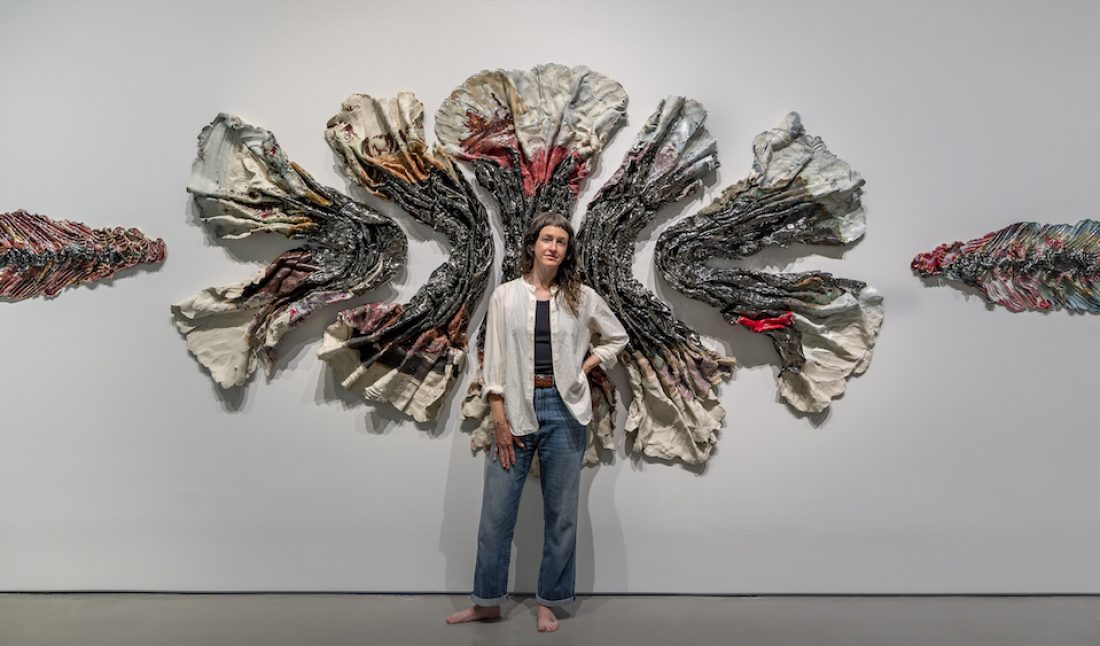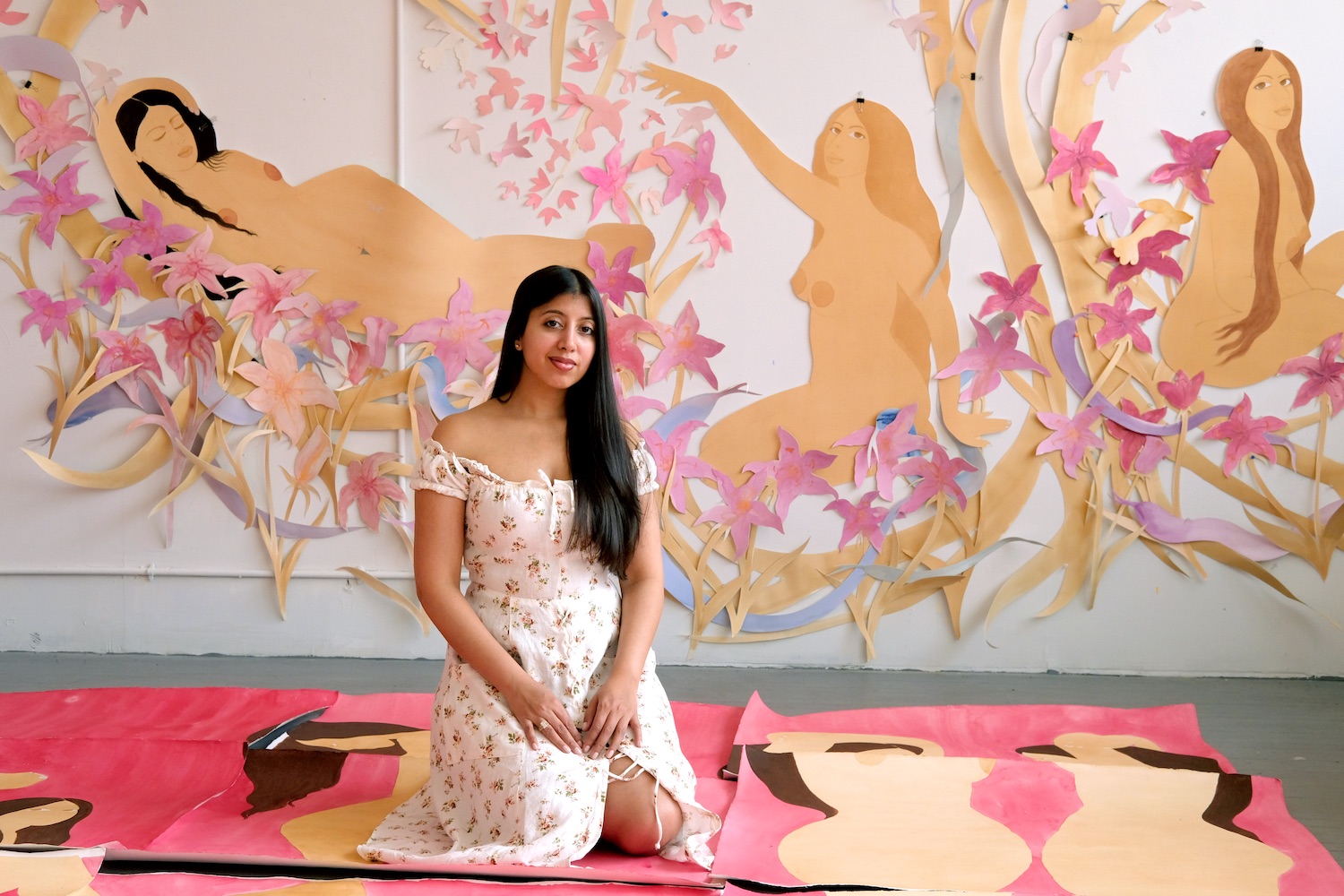Around a decade ago, Brie Ruais began a full-body approach to working with clay that centered process and endurance—a practice which the artist continues to explore, and which involves the equivalent of her body weight in clay used to make each new piece. Pushing, scraping, and molding the earthy medium without the use of tools other than her own body, the resulting works are large, tactile forms that engage with their surroundings, calling on viewers to consider their relationship to land and environment.
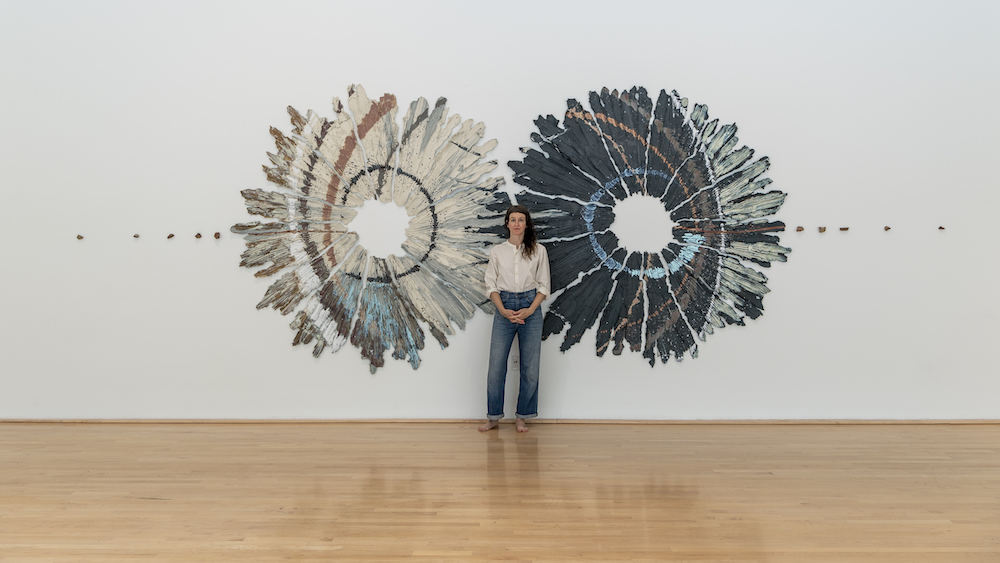 Installation view of Brie Ruais, “Movement at the Edge of the Land,” 2021. Courtesy to Moody Center for the Arts, Houston and albertz benda gallery, NYC. Photo by Nash Baker.
Installation view of Brie Ruais, “Movement at the Edge of the Land,” 2021. Courtesy to Moody Center for the Arts, Houston and albertz benda gallery, NYC. Photo by Nash Baker.
The latest example of these monumental creations can be seen in Ruais’s exhibition “Movement at the Edge of the Land,” within the Moody Center for the Arts at Houston’s Rice University. On view through August 28, the artist has conceived a site-specific presentation of the large ceramic works—which evoke ideas of organically-occurring forms through their earth tones, textured surfaces, and abstract shapes—presented in an installation of materials found in nature, like walls of rocks and stones, or giant mounds of dirt. Extending, as the title suggests, all the way outdoors, the exhibition is complete with a series of photographs and a video work, which documents the process-centric nature of Ruais’s work.
Curious about the show and the artist’s intuitively physical approach, Whitewall caught up with Ruais to learn more.
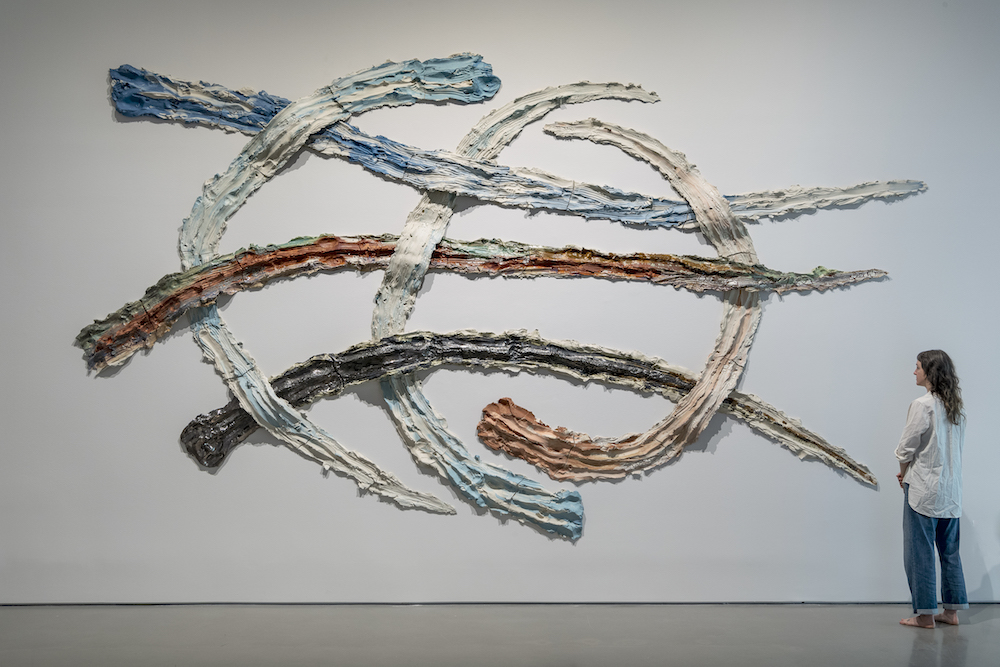 Installation view of Brie Ruais, “Movement at the Edge of the Land,” 2021. Courtesy to Moody Center for the Arts, Houston and albertz benda gallery, NYC. Photo by Nash Baker.
Installation view of Brie Ruais, “Movement at the Edge of the Land,” 2021. Courtesy to Moody Center for the Arts, Houston and albertz benda gallery, NYC. Photo by Nash Baker.
WHITEWALL: “Movement at the Edge of the Land” is an experience that really takes over the Moody Center. What was the starting point for the exhibition?
BRIE RUAIS: The architecture of the Moody Center for the Arts and curator Frauke Josenhans’ invitation to engage with the outdoor space as well as the galleries was what inspired the work for the show. My work is informed by the feeling of being in a place, so I tuned into what each space evoked. The Brown Foundation gallery has an enclosed, cyclical feeling, which reminded me of how I feel living in New York City. And the Central gallery has an open, horizontal, porous feeling that evoked my experience being in the desert. So, the work took on gestures and themes of compression and expansiveness.
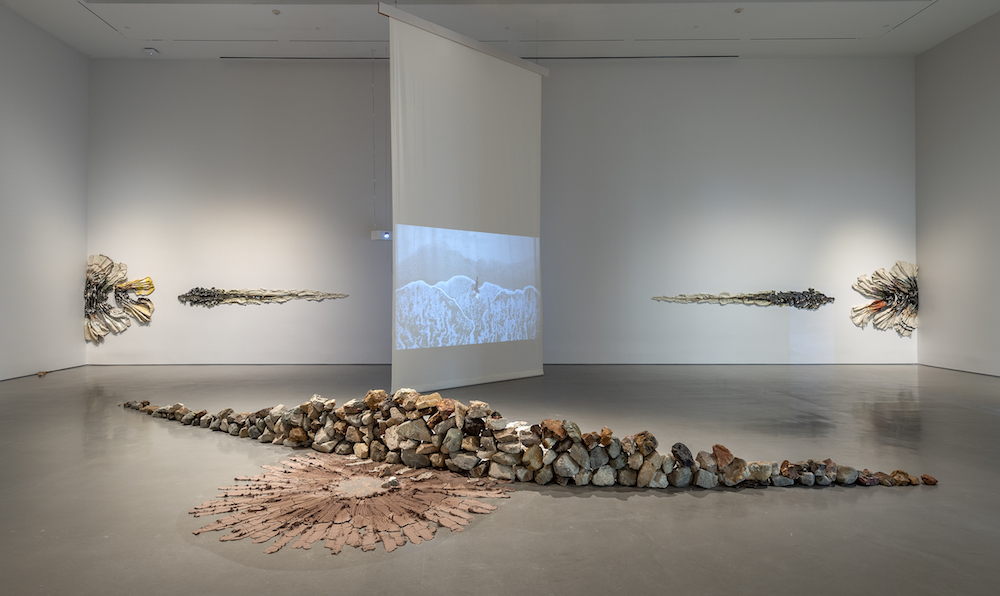 Installation view of Brie Ruais, “Movement at the Edge of the Land,” 2021. Courtesy to Moody Center for the Arts, Houston and albertz benda gallery, NYC. Photo by Nash Baker.
Installation view of Brie Ruais, “Movement at the Edge of the Land,” 2021. Courtesy to Moody Center for the Arts, Houston and albertz benda gallery, NYC. Photo by Nash Baker.
WW: The exhibition title is mirrored by the works, which literally extend to “the edge” of the gallery space, outdoors. What is the significance of the title?
BR: I’m excited that you draw that parallel. I think of the edge as a turning point or place for transformation. I feel like I live at the edges of the human-centered world, so it’s on my mind a lot.
Today I hiked up a mountain. Looking ahead I saw cliffs, trees, the sky, and my dog wandering up the trail. When I arrived at the top, I finally turned around to see where I had come from: a valley dense with houses, roads, cars, cell towers. I like standing at these edges, because I think that from these vantage points we can turn around and look back at ourselves with curiosity and openness to change.
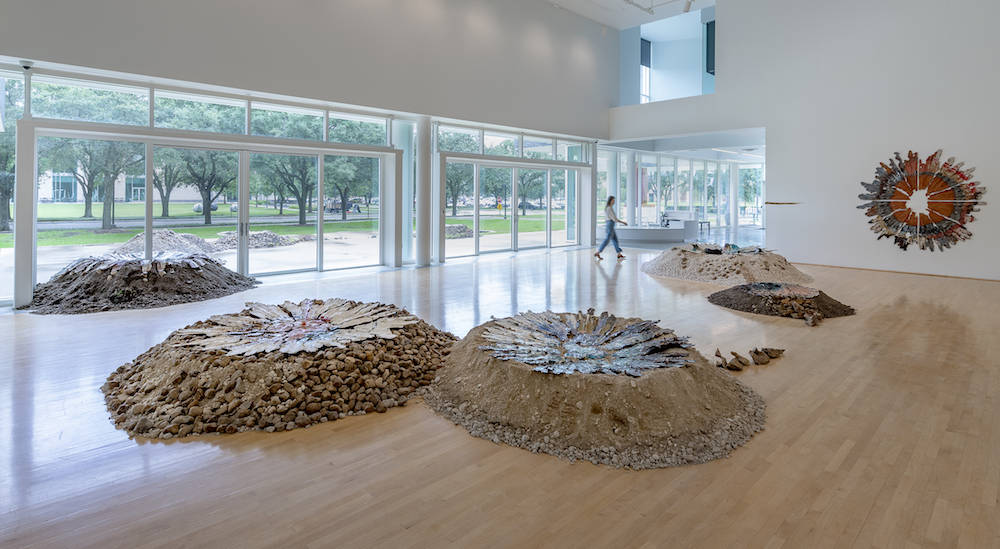 Installation view of Brie Ruais, “Movement at the Edge of the Land,” 2021. Courtesy to Moody Center for the Arts, Houston and albertz benda gallery, NYC. Photo by Nash Baker.
Installation view of Brie Ruais, “Movement at the Edge of the Land,” 2021. Courtesy to Moody Center for the Arts, Houston and albertz benda gallery, NYC. Photo by Nash Baker.
WW: The show includes video and photography, in addition to more tactile work. Can you tell us about these works and the kind of narrative they create in tandem with your ceramics?
BR: The video and photo works attempt to express, up until now, a nearly invisible part of my practice. I‘ve been making ephemeral clay works in the landscape for five years now and have never shown any representations of them. The gestures I cultivate out there come into the studio work. The video and photo work bridges that leap. They reveal the intimacy between the body, the land, and clay by capturing the context in which they come together. People have been really responsive to them, which has made me reflect upon how easy it is (for me and the viewer) to take for granted the ceramic object’s relationship to the earth.
WW: How are you thinking about the scale of the works, and what role does that play in the making, in your process?
BR: The scale of the work has always been determined by this one decision I made early on: It is my body weight. Because of this, it has an inherent one-to-one relationship to the viewer’s body, they’re almost like bodies unto themselves. The size of the work is close to human-scale, which is a bit larger than clay really wants to be. So, I have to make decisions about how to divide the work into smaller sections. Sometimes I cut them into a grid with a knife, or tear them into large swathes, or let them desiccate naturally, like dried mud in the desert. That’s what’s interesting about process: it opens up opportunities to engage in ways you couldn’t have predicted.
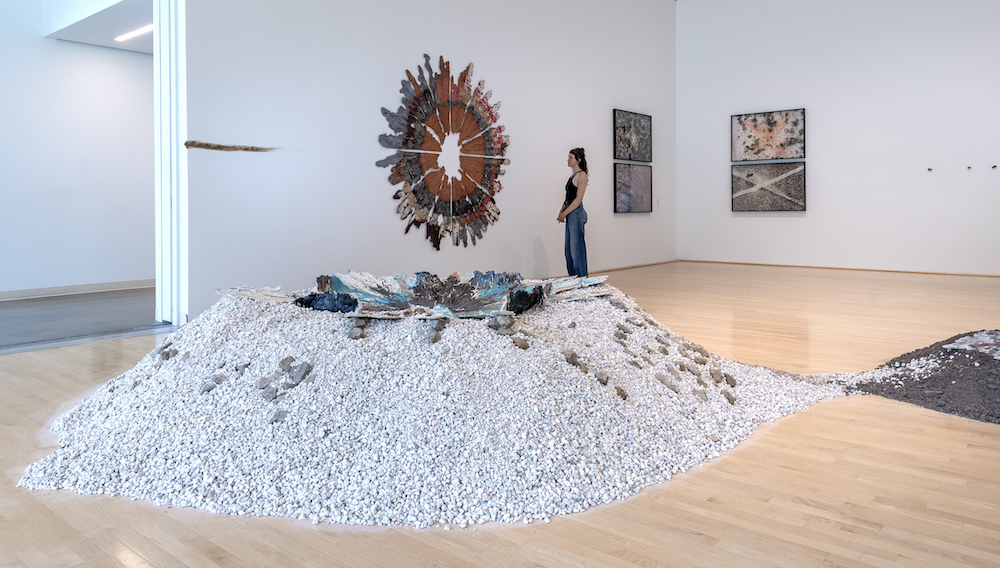 Installation view of Brie Ruais, “Movement at the Edge of the Land,” 2021. Courtesy to Moody Center for the Arts, Houston and albertz benda gallery, NYC. Photo by Nash Baker.
Installation view of Brie Ruais, “Movement at the Edge of the Land,” 2021. Courtesy to Moody Center for the Arts, Houston and albertz benda gallery, NYC. Photo by Nash Baker.
WW: Clay is known to be a very intuitive medium and you’ve even said, “My work starts from a place that I can’t explain. The performative actions that generate the sculptures tap into the body’s knowledge as opposed to the mind. I let the body and clay lead.” What kind of space does your mind visit when you’re immersed in the work? Do you typically know before you begin what you’re going to create?
BR: I have the movements in mind before I make the work, it’s kind of a task set before me, meant to be immersive and all-consuming. I set it up this way so I don’t have to think about the form when I’m making it— I prefer not to leave room for doubt and criticality. It doesn’t belong in the space of creating. Afterward, yes. But not during. Elizabeth Grosz says it better than I do, I try to trust that “The body is the instrument by which all information and knowledge is received and meaning is generated.”
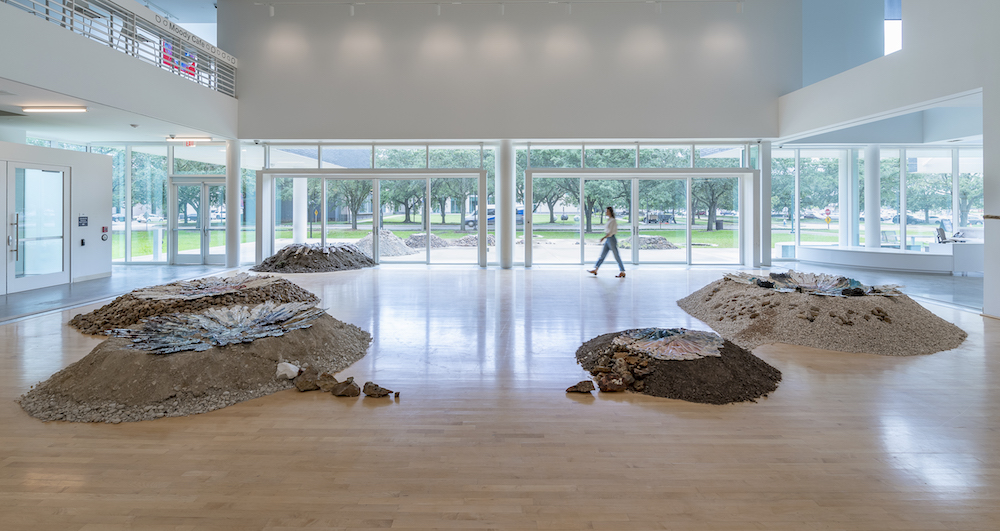 Installation view of Brie Ruais, “Movement at the Edge of the Land,” 2021. Courtesy to Moody Center for the Arts, Houston and albertz benda gallery, NYC. Photo by Nash Baker.
Installation view of Brie Ruais, “Movement at the Edge of the Land,” 2021. Courtesy to Moody Center for the Arts, Houston and albertz benda gallery, NYC. Photo by Nash Baker.
WW: How did you first begin exploring such an involved relationship with materials and environment?
BR: People in ceramics use the phrase “clay body” when they’re describing the qualities of a clay mixture. I love how this phrase suggests a deep understanding of what we are made of. We are made out of earth! I suppose I’ve been involved with the environment from the very beginning.
WW: We’ve heard you have lots of things coming up soon. What should we be on the lookout for?
BR: I have a lot of new work coming through! I’m in New Mexico now harvesting wild clay from a Tanuga clay quarry. I recently made an ephemeral work inspired by the artist, Denise Lynch, who stewards the site. This piece will find its way into my solo show with Albertz Benda. And the Deitch group show, “Clay Pop,” will be a treat this fall—it’s a very dynamic group of ceramic sculptors, I’m excited to be part of it.
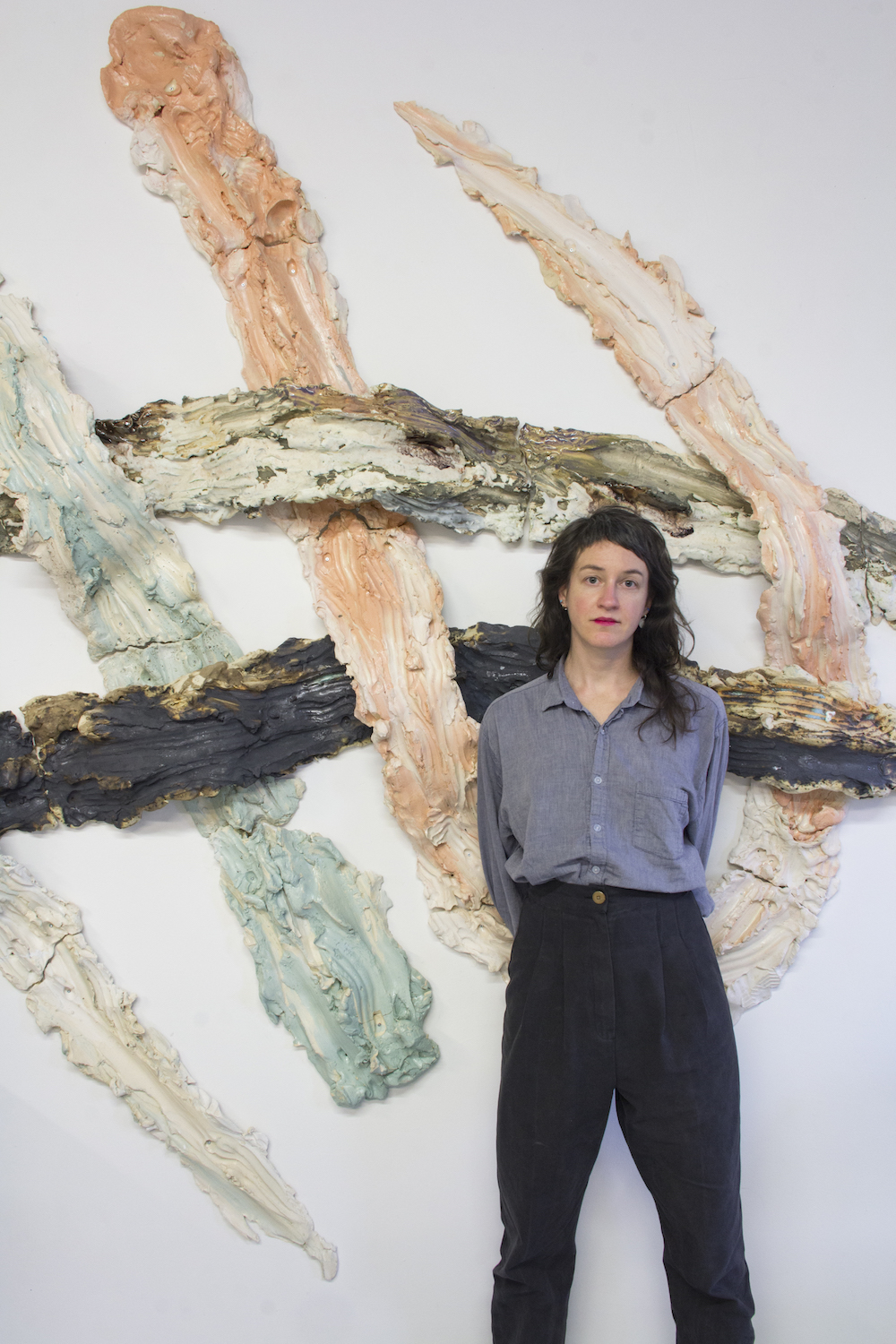 Installation view of Brie Ruais, “Movement at the Edge of the Land,” 2021. Courtesy to Moody Center for the Arts, Houston and albertz benda gallery, NYC. Photo by Nash Baker.
Installation view of Brie Ruais, “Movement at the Edge of the Land,” 2021. Courtesy to Moody Center for the Arts, Houston and albertz benda gallery, NYC. Photo by Nash Baker.







